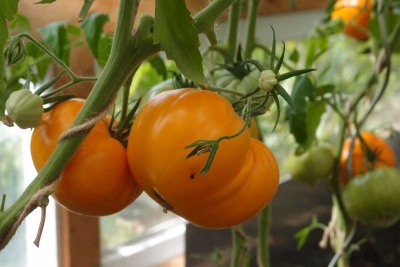
- Authors: Shott Z.I., Gilev M.A.
- Year of approval: 2007
- Category: grade
- Growth type: indeterminate
- Appointment: fresh consumption, for juice
- Ripening period: mid-season
- Ripening time, days: 110-115
- Growing conditions: for open ground, for film greenhouses
- Bush size: tall
- Bush height, cm: more than 150
The authors of the Altayskiy variety are the breeders Shott ZI and Gilev MA In 2007, it was included in the State Register and approved for use in all regions.
Description of the variety
Tomato bushes are indeterminate, tall, in height they can reach more than 150 cm. If the plant is grown in greenhouse conditions, the height of the bushes reaches 2 meters. The foliage of the bush is large, light green in color. The inflorescence is simple, collected in a brush. The peduncle is articulated.
The main qualities of the fruit
Tomatoes of this variety are large, flat-round, slightly ribbed in shape. Unripe fruits are green, with a dark green spot at the stalk. When fully ripe, the color of the fruit turns bright orange. The mass of one tomato is 250-300 g. The maximum fruit weight can reach 500 g. Tomatoes, besides fresh consumption, can be used for making juice or puree.
Taste characteristics
The fruit tastes very rich and harmonious. The flesh of the fruit is quite firm, but juicy and fleshy.
Ripening and fruiting
The ripening period of the Altai orange tomato is mid-season, fruiting begins at 110-115 days.
Yield
Altai has a high yield, which depends on care and growing methods. In the greenhouse, the yield is higher than in the open field. Up to 4.5 kg of tomatoes can be harvested from one bush, and from 1 square meter. up to 10 kg. The first ripening of fruits begins in mid-July, the latter can last until the first frost.
The timing of planting seedlings and planting in the ground
Sowing seeds must begin from March 20 to April 10. Before planting in the ground, seedlings should be at least 65 days old. Tomato seeds should be sown in one deep seedling container. You can prepare the soil for planting yourself. It consists of equal parts of humus, sod land and low-lying peat. Fertilizers must be applied to the soil in the form of superphosphate and urea.
Seeds are sown one at a time, the distance between which is 5 mm. Plant germination occurs on the 6th day. Planting dates depend on the region and climatic conditions. The best planting time is early June.

Growing tomato seedlings is an extremely important process, because it largely depends on whether the gardener will be able to harvest at all. All aspects must be taken into account, from seedbed preparation to planting in the ground.
Landing scheme
Tomatoes are planted in open ground depending on weather conditions. Planting seedlings must be done from May 15 to June 5. The air temperature during disembarkation should be at least +18 degrees. The formation of holes should be done according to the scheme 50x40 cm. 3-4 seedlings should be planted per 1 square meter. Seedlings are transplanted into the ground by the transshipment method. When planting, the soil is fertilized with humus and urea.
If tomato seedlings are strongly stretched, they must be planted in the ground at an angle. Elongated plants must be immediately tied to a support; for this, pegs must be used.

Growing and care
Rooting of seedlings occurs two weeks after planting tomatoes. With the onset of this period, it is necessary to start watering. In the open field, in the absence of rain, tomatoes are watered once a week. If the plant is grown in a greenhouse, then watering is done once every 3 days, due to the rapid drying of the soil.
The best growing season for a tomato is one or two stems. This will give the plant larger fruits. If it is necessary to increase the amount of the crop, then the tomato is formed into three stalks. The plant must be pinned weekly. When fruits appear on the lower part of the bush, the lower leaves must be removed.
Tomato bushes are tall, so they need a garter. It is produced 10 days after planting the seedlings; supports or trellises are well suited for this.
You need to feed the plant at least 2 times per season. During the bud ovary period, you need to fertilize the bushes with mullein infusion. During the period of abundant fruiting, it is necessary to feed the plant with a mineral fertilizer based on potassium.




A plant needs different micronutrients at each stage of growth. All fertilizers can be divided into two groups: mineral and organic. Folk remedies are often used: iodine, yeast, bird droppings, eggshells.
It is important to observe the rate and period of feeding. This also applies to folk remedies and organic fertilizers.
Disease and pest resistance
With timely preventive procedures, the plant develops resistance to infections and pests. Tomato bushes are quite well adapted to fusarium, late blight and verticillosis. To prevent root and fruit rot, it is recommended to monitor the soil: regularly loosen and mulch the soil.
During flowering, tomato bushes can be harmed by insects: aphids, Colorado potato beetle, spider mites. For the prevention of pests, the bushes must be treated with ammonia solution.


Growing regions
Recommended growing regions of this variety: North, North-West, Central, Volgo-Vyatka, TsChO, North Caucasian, Middle Volga, Nizhnevolzhsky, Ural, West Siberian, East Siberian, Far East.
Review overview
Reviews of the Altai orange variety are mostly positive. Reviews speak of excellent taste, high yield, unpretentious care during the entire period of tomato growth. The plant takes root very well and yields consistently.

























































































